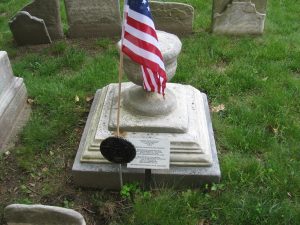John McGinley
Biography
Revolutionary War Officer
Blacksmith
Service 1777 – 1781


John McGinley is buried at Old Pine Street Churchyard and a marker is in place signifying his participation in the Revolutionary War.

John McGinley served as an officer in the Revolutionary War, serving from 1777 until 1781. In that era, service was primarily as needed rather than a full-time job. Thus, he most likely was called into service when the need arose and then returned to his normal life as a blacksmith when relieved of his duties.
John McGinley was a member of multiple companies in the Philadelphia Militia Artillery. He served as a Lieutenant. and Lieutenant Captain in John Eyre’s artillery battalion under Captain Samuel Massey (First Company). April 25, 1779, he moved to the role of Captain of the same company, succeeding Captain Massey.
John McGinley’s role in the military was one of utilizing his blacksmith capabilities. He and his men made gun carriages, a chevaux-de-frise (device with spikes to slow the enemy), and performed iron work in the building of the fort on Mud Island (Ft. Mifflin). During the building of the fort, Captain McGinley was a superintendent of the blacksmiths and supervised the ironsmiths under the supervision of Colonel Bull.
Later, John McGinley filled the role of Captain Lieutenant of the James Pearson’s company (5th Company) of the artillery battalion of Philadelphia Militia commanded by Lt. Col. Joseph Marsh. Likewise, he was the Captain Lieutenant of the Fourth Company of Lieutenant Colonel Joseph Mark’s artillery battalion.
See a detailed log of John McGinley’s Revolutionary War Service. (Password Required)
Advocacy
John McGinley was also an advocate for his men. Shortly after his company arrived on Mud Island, he sent communication indicating the unhappiness of the company over poor pay, mistreatment, and lack of supplies. It is unclear as to the exact conditions on the island, but that summer has been described as being particularly hot and humid with many of the people experiencing fevers.
Later that summer, Captain McGinley complained that his men had not been paid in a month and refused to keep working for the going rate. It appears that the men were being paid what was referred to as the Philadelphia wage, which was applied to all tradesman work in the militia. However, John McGinley contended that the going rate for their services in Philadelphia was much higher. At one point, he paid the men directly from his own funds at £8 per day. He attempted to get reimbursed, however, he was limited to the rate of £1 per day. Thus, John McGinley lost a considerable amount of his own money.¹
Read this communication and others regarding pay for his men. (Password Required)
When relieved of their duties on Mud Island, Capt. McGinley’s Company marched to the State House in a show of support to the Supreme Executive Council of Pennsylvania regarding creating regulations on the pricing, sale, and transport of goods. After assuring the Supreme Executive Council of their support, they proceeded to the college where the committee on this topic was meeting. They reiterated their support for efforts to reduce the price of goods.
Read the Company Memorial. (Password Required)
Second Continental Congress
A marker added by Old Pine Church on John McGinley’s grave and the website http://mcginleyclan.org both claim that John McGinley was also a representative to the Second Continental Congress. However, proof of this contribution to the founding of our country has not be found.² Confusion may have arisen from the fact that he was one of many signers of a couple of addresses from the citizens of Philadelphia to the Congress.
Land in West Virginia
When John died in 1804, he gave all his property to Margaret including his property in Monongalia County, Virginia (now West Virginia). The exact location of this property and how he came to own it remains to be discovered. However, it may have been compensation for his war effort and monies he personally paid to the men in his company.
¹The story that was told by his family was simply that he had paid his men with his own money and thus had little money after the war. Records helped to create a clearer story of what happened.
²The notes of the researcher for Old Pine Church Graveyard have also been reviewed. Nothing regarding John McGinley in this role was found.